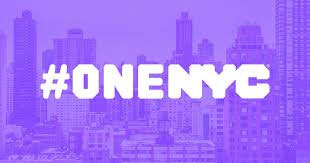by Rona Fried
New York City Mayor de Blasio surprised everyone with the latest version of the city’s impressive long term sustainability plan.
The previous mayor, Michael Bloomberg, put PLANYC in place seven years ago and its breadth and depth has become a model for cities in the US and around the world.
de Blasio is making it even more comprehensive by turning it into a sustainable development plan, focusing equally on the environment and income inequality.
The new name is OneNYC – short for "One New York: The Plan for a Strong and Just City."

The move is analogous to international climate discussions, which acknowledge the need to lift poor nations in order to succeed.
Energy bills, for example, are a much higher proportion of housing expenses for low income people, amounting to a regressive tax, says de Blasio, and they often live in less efficient buildings than wealthier residents.
"We know that if we only have environmental sustainability and end up with a gilded city only for the most wealthy, it will no longer be New York. And equally, if we have a city filled with economic opportunity and inclusion but it isn’t environmentally viable and sustainable, it won’t work. So we’ve got to bring these two pieces together," de Blasio said as he announced OneNYC.
Amazing that almost half of the people who live in NYC (45%) are at or near the poverty level.
"When Hurricane Sandy hit, environmental justice advocates pointed out how we couldn’t think about physical vulnerability to climate change without thinking about local economics and inequality," Juan Camilo Osorio of the NYC Environmental Justice Alliance told InsideClimate News.
OneNYC builds on PLANYC with some 200 goals, to be detailed in the city’s budget in early May. The overriding goal is to cut emissions 35% by 2025 and 80% by 2050.
On the social side:
- lift 800,000 residents out of poverty or near poverty by 2025, the most aggressive effort ever made in the US
- significantly reduce racial/ethnic disparities in premature mortality
- create 500,000 affordable housing units by 2040, to accommodate growth projected to 9 million residents.
- the average person will be able to commute to work via mass transit within 45 minutes
- raise the minimum wage to $13 in 2016, indexed to inflation (requires legislation on the state level)
- expand and diversify jobs
- reduce the cost of Internet service
- increase access to health care and provide free pre-Kindergarten
On the environmental side:
- continue Bloomberg’s vast array of programs, such as dramatically increasing building efficiency, increasing renewable energy and green infrastructure
- cut emissions from wastewater treatment plants
- target emissions cuts from power plants and transportation
- zero waste to landfills by 2030 by dramatically increasing recycling and composting, while phasing out styrofoam and plastic bags
- expand the city’s bike-share program
- remediate and repurpose polluted sites
- continue implementation of Bloomberg’s $20 billion plan, "A Stronger, More Resilient New York" – involve communities in emergency preparedness; build defenses to rising sea levels; harden infrastructure against flooding, such as power and transportation.
A few weeks ago, the Mayor announced that low income housing would get a $100 million energy efficiency lift.
NYC’s 10-year capital plan includes at least $1 billion for municipal building upgrades such as schools, hospitals, libraries, fire and police stations. Combined with private sector building retrofits, the plan is expected to produce $1.4 billion a year in energy savings while shaving off 10% of emissions (adding to the 19% cuts under Mayor Bloomberg).
Another goal is 100 megawatts of solar on 300 public buildings paired with energy storage at emergency shelters, and 250 MW on private buildings, enough to power over 110,000 households.
Scientists estimate at least six feet of sea level rise by the turn of the century and temperatures could by as much as 8.8 degrees Fahrenheit higher by the 2080s – the number of days above 90 degrees could jump from 18 presently to 76 by then, reports InsideClimate News.
This month, NYC joined 16 of the world’s largest cities in forming the Carbon Neutral Cities Alliance.
Here’s the plan:


hi may i know who the author is ? im doing a “craap” analysis on this article. btw this article is AWESOME!